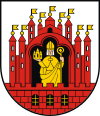Graudentz
| Grudziądz | |||
|---|---|---|---|
 
City panorama (top)
Grudziądz residential district (bottom) |
|||
|
|||
| Motto: Grudziądz - miasto na szczęście (Grudziądz - city of good luck) |
|||
| Coordinates: 53°29′33″N 18°46′34″E / 53.49250°N 18.77611°E | |||
| Country | Poland | ||
| Voivodeship | Kuyavian-Pomeranian | ||
| County | city county | ||
| Established | 11 April 1065 | ||
| Town rights | 18 June 1291 | ||
| Government | |||
| • Mayor | Robert Malinowski | ||
| Area | |||
| • Total | 57.76 km2 (22.30 sq mi) | ||
| Elevation | 50 m (160 ft) | ||
| Population (2010) | |||
| • Total | 96,042 | ||
| • Density | 1,700/km2 (4,300/sq mi) | ||
| Time zone | CET (UTC+1) | ||
| • Summer (DST) | CEST (UTC+2) | ||
| Postal code | 86-300 to 86-311 | ||
| Area code(s) | +48 056 | ||
| Car plates | CG | ||
| Website | http://www.grudziadz.pl | ||
Grudziądz [ˈɡrud͡ʑɔnt͡s] (German: Graudenz, Latin: Graudentum or Graudentium or Grudentia) is a city of around 96,042 inhabitants (2010) on the Vistula River in northern Poland. Situated in the Kuyavian-Pomeranian Voivodeship (since 1999), the city was in the Toruń Voivodeship from 1975 to 1998.
Grudziądz is located close to the east shore of river Vistula, approximately 22 kilometres (14 miles) north-east of Świecie, 93 km (58 mi) south of Gdańsk and 170 km (106 mi) south-west of Kaliningrad.
Initially Grudziądz was a defensive gród founded by Polish ruler Bolesław Chrobry.
The settlement was re-fortified again from 1234 by the Teutonic Order; the erection of the castle with the help of stone as building material was begun with around the middle of the 13th century. Under the protection of the castle the settlement gradually begun to develop to a town. In 1277 both "the castle and the town" were besieged heavily by the Yotvingians. The settlement adopted Kulm law in 1291 while under the rule of the monastic state of the Teutonic Knights.
The oldest building parts of the Catholic St. Nicholas' Church stem from the end of the 13th century. The Holy Spirit Church, which apparently was founded already during the 13th century, is mentioned together with the town's hospital for the first time in 1345. Also other documents reveal that in the 14th century the town had already a well-developed infrastructure. A document of 1380, as an example, refers to the construction of an aqueduct, of a fountain and of the establishment of a town-hall cellar.
...
Wikipedia



